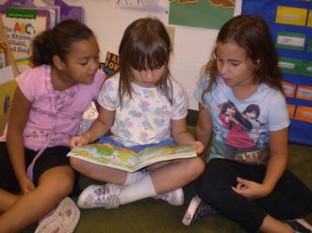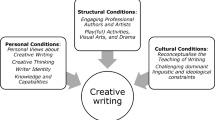Abstract
This study uses a Vygotskian approach and a socio-cultural lens, as well as the Transactional Reading Theory to investigate how social interactions and literary transactions can combine through buddy reading to empower young readers and promote literacy in a first grade classroom. The research focuses on how literary transaction and social interaction work together to facilitate emergent and early readers in a ‘partner/buddy’ reading approach. The research question asked whether or not ‘partner/buddy’ reading can promote literacy through social interaction, and yielded three major themes, including the use of reading strategies to scaffold learning, making connections with and to the text in order to construct meaning, and using play as a type of social interaction and motivational method. The findings suggest that buddy reading as a classroom tool can effectively promote literacy and learning in a cooperative setting.


Similar content being viewed by others
References
Bodrova, E., & Leong, D. (1996). Tools of the mind: The Vygotskian approach to early childhood education. Columbus, OH: Merrill/Prentice Hall.
Christie, J. F., & Roskos, K. A. (2009). Play’s potential in early literacy development. In: R. E. Tremblay, R. G. Barr, R. De V. Peters, M. Boivin (Eds.), Encyclopedia on early childhood development [online]. Montreal, Quebec: Centre of Excellence for Early Childhood Development:1–6. Available at: http://www.child-encyclopedia.com/documents/Christie-RoskosANGxp.pdf. Accessed [April 2010].
Cochran-Smith, M. (1984). The making of a reader. Norwood, NJ: Ablex Publishing.
Cronin, D. (2000). Click, clack, moo: Cows that type. New York, NY: Simon & Schuster.
Griffin, M. L. (2002). Why don’t you use your finger? Paired reading in first grade. The Reading Teacher, 55(8), 766–774.
Hubbard, R. S. & Power, B. M. (1993, 2003). The art of classroom inquiry: A handbook for teacher researchers. Portsmouth, NH: Heinemann.
MacGillivray, L., & Hawes, S. (1994). “I don’t know what I’m doing-they all start with B”: First graders negotiate peer reading interactions. The Reading Teacher, 48(3), 210–217.
Masurel, C. (2000). Ten dogs in the window: A countdown book. Croton on Hudson, NY: North-South Books (Houghton Mifflin Big Book Series).
Rosenblatt, L. M. (2001). The literary transaction: Evocation and response. Theory into Practice, XXI(4), 268–277.
Shannon, D. (1998). No David! New York, NY: Scholastic Publishing.
Vygotsky, L. S. (1978). Mind in society: Development of higher psychological processes. Cambridge, MA: Harvard University Press.
Author information
Authors and Affiliations
Corresponding author
Rights and permissions
About this article
Cite this article
Flint, T.K. Making Meaning Together: Buddy Reading in a First Grade Classroom. Early Childhood Educ J 38, 289–297 (2010). https://doi.org/10.1007/s10643-010-0418-9
Published:
Issue Date:
DOI: https://doi.org/10.1007/s10643-010-0418-9



